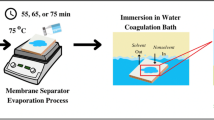Abstract
Vanadium Redox Battery (VRB) is one of the promising electrical energy storage systems. The charge/discharge efficiency of VRB is affected by the permeability of vanadium ions, the water or acid uptake, and the ionic conductivity. In this study, a cellulose acetate/polypropylene (CA/PP) composite nano-porous membrane was prepared. The solvent/non-solvent method was used to form the CA membrane. It was supported on a PP fabric. The polyethylene glycol (PEG) was a pore-forming agent in the CA solution. This composite membrane had shown good ionic conductivity and low permeation to the vanadium ion as the commercial proton conducting membrane (Nafion). However, the membrane cost is expected to be one order of magnitude lower than the cost of Nafion.
Similar content being viewed by others
References
De Leon C.P., Frias-Ferrer A., Gonzalez-Garcia J., Szanto D.A., and Walsh F.C., Redox flow cells for energy conversion, J. Power Sources, 2006, 160: 716.
Tokuda N., Kanno T., Hara T., Shigematsu T., Tsutsui Y., Ikeuchi A., Itou T., and Kumamoto T., Development of a redox flow battery system, SEI Technical Review, 2000, 50: 88.
Huang K.L., Li X.G., Liu S.Q., Tan N., and Chen L.Q., Research progress of vanadium redox flow battery for energy storage in China, Renewable Energy, 2008, 33: 186.
Zhao P., Zhang H., Zhou H., Chen J., Gao S., and Yi B., Characteristics and performance of 10 kW class all-vanadium redox-flow battery stack, Journal of Power Sources, 2006, 162: 1416.
Zhu S., Sun W., Wang Q., Yin H., and Wang B., Review of R&d status of vanadium redox battery, Chemical Industry and Engineering Progress, 2007, 26(2): 207.
Joerissen L., Garche J., Fabjan Ch., and Tomazic G., Possible use of vanadium redox-flow batteries for energy storage in small grids and stand-alone photovoltaic systems, J. Power Sources, 2004, 127: 98.
Mohammadi T., and Skyllas-Kazacos M., Characterisation of novel composite membrane for redox flow battery application, J. Membrane Science, 1995, 98: 77.
Mohammadi T., and Skyllas-Kazacos M., Preparation of sulfonated composite membrane for vanadium redox flow battery applications, J. Membrane Science, 1995, 107: 35.
Hwang G-J., and Ohya H., Preparation of cation exchange membrane as a separator for the all-vanadium redox flow battery, J. Membrane Science, 1996, 120: 55.
Mohammadi T., Chieng S.C., and Skyllas-Kazacos M., Water transport study across commercial ion exchange membrane in the vanadium redox flow battery, J. Membrane Science, 1997, 133: 151.
Sukkar T., and Skyllas-Kazacos M., Water transfer behaviour across cation exchange membrane in the vanadium redox battery, J. Membrane Science, 2003, 222: 235.
Sukkar T., and Skyllas-Kazacos M., Modification of membranes using polyelectrolytes to improve water transfer properties in the vanadium redox battery, J. Membrane Science, 2003, 222: 249.
Tian B., Yan C.W., and Wang F.H., Proton conducting composite membrane from daramic/nafion for vanadium redox flow battery, J. Membrane Science, 2004, 234: 51.
Qiu J., Li M., Ni J., Zhai M., Peng J., Xu L., Zhou H., Li J., and Wei G., Preparation of ETFE-based anion exchange membrane to reduce permeability of vanadium ions vanadium redox battery, J. Membrane Science, 2007, 297: 174.
Luo Q., Zhang H., Chen J., Qian P., and Zhai Y., Modification of nafion membrane using interfacial polymerization for vanadium redox flow battery applications, J. Membrane Science, 2008, 311: 98.
Teng X., Zhao Y., Xi J., Wu Z., Qiu X., and Chen L., Nafion/organic silica modified TiO2 composite membrane for vanadium redox flow battery via in-situ sol-gel reactions, J. Membrane Science, 2009, 341: 149.
Qiu J., Zhai M., Chen J., Wang Y., Peng J., Xu L., Li J., and Wei G., Performance of vanadium redox flow battery with a novel amphoteric ion exchange membrane synthesized by two-step grafting method, J. Membrane Science, 2009, 342: 215.
Author information
Authors and Affiliations
Corresponding author
Rights and permissions
About this article
Cite this article
Lin, YC., Huang, SL., Yeh, CH. et al. Preparation of cellulose acetate/PP composite membrane for vanadium redox flow battery applications. Rare Metals 30 (Suppl 1), 22–26 (2011). https://doi.org/10.1007/s12598-011-0230-8
Received:
Revised:
Accepted:
Published:
Issue Date:
DOI: https://doi.org/10.1007/s12598-011-0230-8




